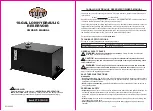
Document No: LT0255
F3200/NDU AS4428.1 Installation Manual
Configuring a FIP
Issue 1.22
5 July 2016
Page 4-3
4.3
BATTERY & POWER SUPPLY
4.3.1
GENERAL
The F3200 FIP has a dc power supply, which also serves as battery charger and requires a
24V sealed lead acid battery (i.e. 2 x 12V batteries in series) to be fitted. (See Section 3.3.3
for compatible batteries). Battery leads with 4.8mm Quick Connect receptacles (for
connecting to the battery tabs) are included.
Charger Rating
(Refer to AS1670.1 Section 3.16).
The standard F3200 has a 3A power supply. Versions are also available with a 6A PSU.
This has a second mains transformer, a 3A rectifier PCB and a larger heatsink connected to
the MAF/PSU. Several components on the PCB are also upgraded.
When a 6A power supply is fitted, the standard PTCs on the MAF/PSU are shorted out and
additional battery protection must be fitted (see Section 4.3.5).
To comply with AS1670.1 the power supply rating must be sufficient to charge the batteries
while powering the panel with 2 zones in alarm. This includes all remaining quiescent loads,
common alarm load, plus 2 (or 20%, whichever is greater) of all connected fire suppression
systems in the active state (i.e. solenoids, warning signs, etc).
The definition of charging the batteries is supplying enough current to charge them within 24
hours to provide a capacity that will support 5 hours of FIP quiescent load (i.e. with mains
off) followed by 0.5 hour of alarm load for two, worst case zones.
The recommended order of performing calculations is listed in Section 4.3.2.
Battery Rating
(Refer to AS1670.1 Section 3.16).
The battery capacity must be sufficient to support 24 hours of quiescent load (i.e. with mains
off), followed by 0.5 hour of alarm load for two worse case zones.
Notes
1.
The quiescent load includes the FIP electronics (in normal state) plus any external
normally energised loads that operate from the battery backed supply. Hence door
holders are normally supplied from a non-battery backed supply.
2.
Alarm load includes FIP electronics (in alarm state) plus any external loads such as
common Warning System, air conditioning shutdown relays, etc, plus the 2 (or 20%)
fire suppression zones.
3.
The capacity of a battery depends on the rate (i.e. current) at which it is discharged.
Most batteries are quoted at a 20 hour discharge, e.g., a 10Ah battery will supply
0.5A for 20 hours. At 3 times the current (i.e. 1.5A) the same battery will discharge in
typically 5.6 hours, i.e. the capacity is only 8.5Ah. At 10 times the rate the capacity is
approximately 75% of the 20 hour rate capacity (i.e. 7.5Ah). Hence for alarm loads it
is safest to derate the capacity to 50%.
















































